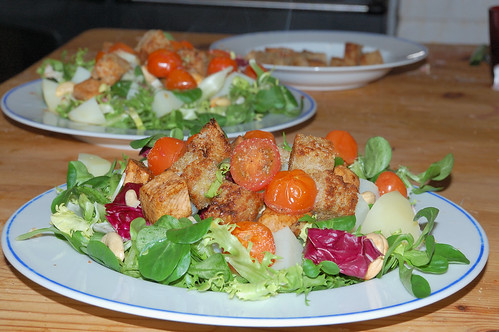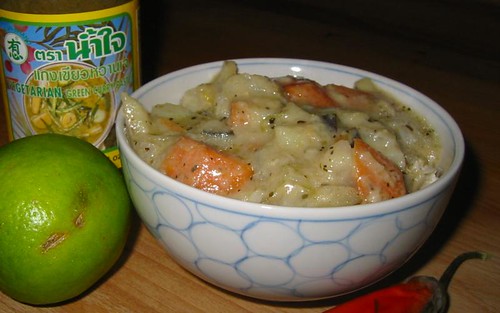
We had a wonderful late harvest in November of Savoy type cabbages and large Winter Radishes which supplied the makings for a European version of Kim Chee, the essential fermented cabbage pickle of Korea and other Asian countries.
The pickles I made 2 months ago are now reaching a peak of flavour and crunchiness and I've been enjoying them, simmered for a minute in a little hot water as an instant hot and sour soup for breakfast. It's wonderful stuff, full of flavour and low calorie but I suspect that Mr. Stripey Cat might have a thing or two to say about body odour when he gets back from his most recent trip away.
Anyway, the most important part about this posting is that you don't need to worry if you can't get Chinese cabbages and mooli radishes, the brassicas of Northern Europe will rise to the challenge.
Take a large firm cabbage, I used the one in the picture above, something fairly leafy but still with a good tight head, then clean off the slugs, mud and withered leaves. Remove a few of the large outer leaves and reserve in the cool while you prepare the rest of the vegetables.
Cut the cabbage head up. You can segment it, make large slices, divide it into quarters, squares, whatever you fancy really as long as the pieces aren't too small and still look appetising. Slice stems and the thick ends of leaves into thin sections or remove altogether. Put it into a large bowl and pour over a brine made from 125g salt to 500ml water. This is strong but necessary to wilt and soften the leaves for the next stage.
Cover the salted cabbage, put a light weight on top to keep it pressed down into the liquid and leave it overnight or for as much as 24 hours. Turn the cabbage in the brine a couple of times if you remember. Next day, the cabbage should be soft and pliable. Squeeze out as much brine as possible with your hands and set the drained cabbage to one side.
Peel the winter radish(es) and cut away any damaged parts or very rooty bits. You need about 500g of the prepared vegetable. Cut it into matchsticks shaped pieces.
Shred a bunch of spring onions (or use shallots or green onions). Clean and crush several cloves of garlic and grate some root ginger, about an inch long piece should be sufficient but have more if you like it.
To make the Kim Chee hot there are various options. Best is to obtain some Korean chili powder, you'll need about 3 tbsps. but this will make it rather hot. Or you can do what I did and slit two or three green chillies and add them to the mix with a couple of tablespoons full of paprika. Or you could crumble dried red chillies in to taste.
Finally you need about a tbsp. of sugar. I don't think any more salt is needed at this point but I did add a couple of tablespoons of shoyu.
Mix the flavourings together and then add them to the cabbage and radish. If your cabbage is still in big sections make sure the mixture gets in between the leaves.
Pack everything into a stoneware or plastic container that can be tightly sealed. Kim Chee needs to be under a slight pressure as it ferments to keep the pickle submerged in its liquid. Cover the top of the pickle with some of your reserved cabbage leaves and fit a plate or lid into the top of the container. Then use something like a full can of beans in a freezer bag (to keep beans and cabbage clean) as a weight. Or you can scrub some stones or whatever, improvise. Seal tightly, not so much for the pickle but to protect your kitchen from the smell!
The pickle needs to ferment at room temperature for four or five days. Over this time the vegetables will exude moisture and the liquid will rise in the pot to cover the mixture. The liquid will be a bit bubbly, don't panic, this is what you want. The pot should be turned and rotated a few times to make sure the juices comes into contact with all the surfaces in the pot. After five days refrigerate to slow the fermentation and start to eat it.
Use a clean pair of tongs each time you remove a portion and replace the wrappings and weight to keep the rest of the pickle covered with juice. It will keep for months.




